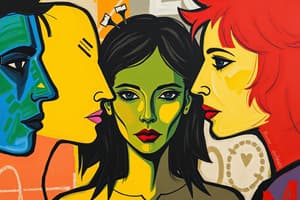Podcast
Questions and Answers
What are some examples of how definitions of deviance vary?
What are some examples of how definitions of deviance vary?
Deviance is behavior or trait that violates cultural norms. Some examples would be burning the flag or the KKK.
How does labeling theory explain deviance?
How does labeling theory explain deviance?
Labeling theory stresses the idea that deviance is a relative term.
What are some examples of how labels can be used as a means of social control?
What are some examples of how labels can be used as a means of social control?
Social processes of labeling and treating someone as criminally deviant actually fosters deviant behavior.
What is the difference between primary and secondary deviance?
What is the difference between primary and secondary deviance?
What is a stigma?
What is a stigma?
How does social conflict theory explain deviance?
How does social conflict theory explain deviance?
How does Steinem's essay ('If Men Could Menstruate') illustrate social conflict theories of deviance?
How does Steinem's essay ('If Men Could Menstruate') illustrate social conflict theories of deviance?
According to Granfield, ('Making It by Faking It'), what skills did working-class students have to acquire to succeed in law school?
According to Granfield, ('Making It by Faking It'), what skills did working-class students have to acquire to succeed in law school?
What is stigma management?
What is stigma management?
What major strategies do people adopt to manage stigma?
What major strategies do people adopt to manage stigma?
What are the three major sectors of the economy?
What are the three major sectors of the economy?
What are the characteristics of pre-industrial societies?
What are the characteristics of pre-industrial societies?
What major changes were associated with the industrial revolution?
What major changes were associated with the industrial revolution?
According to Emile Durkheim, what is the principal challenge facing society?
According to Emile Durkheim, what is the principal challenge facing society?
What is the difference between mechanical and organic solidarity?
What is the difference between mechanical and organic solidarity?
What is anomie?
What is anomie?
How does Karl Marx define social class?
How does Karl Marx define social class?
What are the major classes in a capitalist economy?
What are the major classes in a capitalist economy?
According to Marx, why is capitalism an exploitative system?
According to Marx, why is capitalism an exploitative system?
What is alienation?
What is alienation?
Flashcards are hidden until you start studying
Study Notes
Definitions of Deviance
- Deviance violates cultural norms; examples include flag burning and the actions of the KKK.
Labeling Theory
- Explains deviance as a relative concept, suggesting that definitions of deviance change based on societal context.
Labels as Social Control
- Labels can reinforce deviant behavior through societal reactions, particularly in the sociology of crime.
Primary vs. Secondary Deviance
- Primary deviance is non-consequential behavior not labeled as deviant. Secondary deviance arises from being labeled deviant by society.
Stigma
- A negative label that alters a person's self-concept and social identity.
Social Conflict Theory
- Highlights inequality, suggesting laws and norms serve the interests of the powerful; deviance labels depend on societal power dynamics.
Steinem's Essay and Social Conflict
- Demonstrates how gender dynamics illustrate social conflict and the implications of labeling.
Skills for Working-Class Students
- Working-class students must adapt to elite environments by concealing their backgrounds and adapting social behaviors; illustrates social conflict theories of deviance.
Stigma Management
- Strategies for identity management among individuals with invisible stigmas, involving passing or revealing strategies during interactions.
Major Strategies for Managing Stigma
- Image management approaches include passing, withdrawal, associating with similar individuals, forming counter-cultures, and challenging norms.
Economic Sectors
- Primary: gathers raw materials.
- Secondary: transforms materials into goods.
- Tertiary: offers services.
Characteristics of Pre-Industrial Societies
- Self-sufficient farms/workshops, limited wage labor, craft production, and customized product creation.
Changes from the Industrial Revolution
- Shift to factory work, development of a wage labor force, mass production, and emergence of formal organizations.
Durkheim's Principal Challenge
- Society's challenge is to ensure unity and solidarity among its members.
Mechanical vs. Organic Solidarity
- Mechanical: based on shared values and lifestyles.
- Organic: rooted in interdependence among roles and institutions.
Anomie
- A state of normlessness where society fails to provide moral guidance, leading to social isolation and self-destructiveness.
Marx's Social Class Definition
- The ruling class controls production; contrasts between the bourgeoisie (owners) and the proletariat (laborers).
Major Classes in Capitalism
- Bourgeoisie: owners of production.
- Proletariat: workers with no ownership beyond their labor.
Exploitative Nature of Capitalism
- Capitalism socializes production through workers but allows profits to be seized privately by the bourgeoisie.
Alienation
- A sense of estrangement experienced by individuals, often linked to capitalist production processes.
Studying That Suits You
Use AI to generate personalized quizzes and flashcards to suit your learning preferences.




